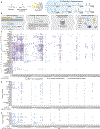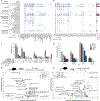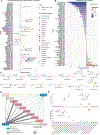The microbiome diversifies long- to short-chain fatty acid-derived N-acyl lipids
- PMID: 40499541
- PMCID: PMC12428309
- DOI: 10.1016/j.cell.2025.05.015
The microbiome diversifies long- to short-chain fatty acid-derived N-acyl lipids
Abstract
N-Acyl lipids are important mediators of several biological processes including immune function and stress response. To enhance the detection of N-acyl lipids with untargeted mass spectrometry-based metabolomics, we created a reference spectral library retrieving N-acyl lipid patterns from 2,700 public datasets, identifying 851 N-acyl lipids that were detected 356,542 times. 777 are not documented in lipid structural databases, with 18% of these derived from short-chain fatty acids and found in the digestive tract and other organs. Their levels varied with diet and microbial colonization and in people living with diabetes. We used the library to link microbial N-acyl lipids, including histamine and polyamine conjugates, to HIV status and cognitive impairment. This resource will enhance the annotation of these compounds in future studies to further the understanding of their roles in health and disease and to highlight the value of large-scale untargeted metabolomics data for metabolite discovery.
Keywords: HIV; MASST; MassQL; N-acyl lipids; SCFA; metabolomics data mining; microbial; neurocognitive impairment; repository-scale analysis; short-chain fatty acids.
Copyright © 2025 The Authors. Published by Elsevier Inc. All rights reserved.
Conflict of interest statement
Declaration of interests P.C.D. is an advisor and holds equity in Cybele, BileOmix, and Sirenas and is a scientific co-founder of, is an advisor to, and holds equity in Ometa, Enveda, and Arome with prior approval by the University of California, San Diego. P.C.D. also consulted for DSM animal health in 2023. M.W. is a co-founder of Ometa Labs LLC. R.K. is a scientific advisory board member of and consultant for BiomeSense, Inc., and has equity and receives income. He is a scientific advisory board member of and has equity in GenCirq. He is a consultant for DayTwo and receives income. He has equity in and acts as a consultant for Cybele. He is a co-founder of Biota, Inc., and has equity. He is a cofounder of Micronoma, has equity, and is a scientific advisory board member. The terms of these arrangements have been reviewed and approved by the University of California, San Diego, in accordance with its conflict-of-interest policies.
Figures




Update of
-
The microbiome diversifies N-acyl lipid pools - including short-chain fatty acid-derived compounds.bioRxiv [Preprint]. 2024 Nov 2:2024.10.31.621412. doi: 10.1101/2024.10.31.621412. bioRxiv. 2024. Update in: Cell. 2025 Jul 24;188(15):4154-4169.e19. doi: 10.1016/j.cell.2025.05.015. PMID: 39554097 Free PMC article. Updated. Preprint.
References
-
- Chang F-Y, Siuti P, Laurent S, Williams T, Glassey E, Sailer AW, Gordon DB, Hemmerle H, and Voigt CA (2021). Gut-inhabiting Clostridia build human GPCR ligands by conjugating neurotransmitters with diet- and human-derived fatty acids. Nat Microbiol 6, 792–805. - PubMed
-
- Mann A, Smoum R, Trembovler V, Alexandrovich A, Breuer A, Mechoulam R, and Shohami E (2015). Palmitoyl Serine: An Endogenous Neuroprotective Endocannabinoid-Like Entity After Traumatic Brain Injury. J. Neuroimmune Pharmacol 10, 356–363. - PubMed
-
- Waluk DP, Vielfort K, Derakhshan S, Aro H, and Hunt MC (2013). N-Acyl taurines trigger insulin secretion by increasing calcium flux in pancreatic β-cells. Biochem. Biophys. Res. Commun 430, 54–59. - PubMed
-
- Aichler M, Borgmann D, Krumsiek J, Buck A, MacDonald PE, Fox JEM, Lyon J, Light PE, Keipert S, Jastroch M, et al. (2017). N-acyl Taurines and Acylcarnitines Cause an Imbalance in Insulin Synthesis and Secretion Provoking β Cell Dysfunction in Type 2 Diabetes. Cell Metab. 25, 1334–1347.e4. - PubMed
-
- Arul Prakash S, and Kamlekar RK (2021). Function and therapeutic potential of N-acyl amino acids. Chem. Phys. Lipids 239, 105114. - PubMed
MeSH terms
Substances
Grants and funding
LinkOut - more resources
Full Text Sources

